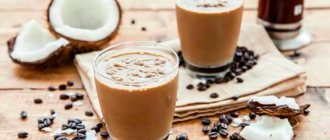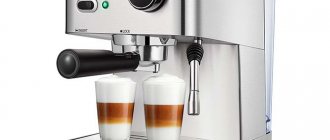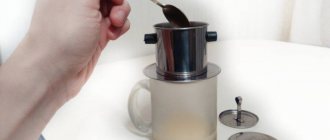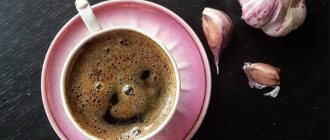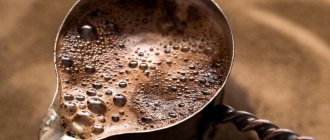It’s not always possible to have a coffee machine or pot at hand to brew a portion of your favorite drink, and instant, although convenient to use, is not to everyone’s taste. There is an elegant, and most importantly, simple way out of this situation - pour ground coffee directly into a cup without any cooking, pour in slightly cooled boiling water and enjoy.
It is surprising that this preparation option seems strange to many, but in the 18th century, when ground coffee began to gain popularity among Europeans, it was brewed this way. Coffee pots, called percolators, appeared a little later - at the beginning of the 19th century.
The benefits and harms of ground coffee for the health of the body
Unlike instant coffee, the chemical composition of which does not fully correspond to the natural product, ground beans, which have not been boiled, retain all the beneficial properties that nature has endowed them with.
In addition to caffeine, the invigorating effect of which everyone knows, grains contain organic acids, lipids (natural fats and oils), vitamins (groups B, E, PP), minerals, tannins, carbohydrates, and proteins necessary for our health.
Thanks to such a rich composition, ground coffee is useful for humans, and its main “bonuses” are the following:
- increasing physical endurance;
- reducing the feeling of hunger (this property of coffee is used in weight loss diets);
- burning fat cells;
- the ability to enhance brain activity and concentrate on work more successfully;
- obtaining additional protection against various diseases (for example, the risk of prostate cancer is reduced by 25%, Parkinson's disease is less likely to develop);
- slowing down the aging process of the body;
- improvement of a person’s moral and psychological state due to the substances included in the product that harmonize mood (for example, serotonin, dopamine).
Natural ground coffee can have a negative effect if the drink is abused. The consequences of this may be:
- insomnia;
- high blood pressure;
- risk of heart attack;
- headache;
- for women – difficulties with conceiving a child and bearing it;
- loss of calcium by the body (caffeine washes it out of the bones);
- hearing impairment.
If we talk about the most severe consequences, you need to keep in mind that a dose of caffeine of 10-15 g is fatal. And although it is unrealistic to get this, since it is contained in 80 cups of coffee, you must always remember to be careful and not abuse your favorite drink.
Ground coffee from unscrupulous manufacturers who artificially “increase” the weight of an expensive product by adding various impurities can also pose a danger. Some of them sometimes contain toxic substances.
Preparation in a coffee machine
Using an automatic coffee machine is the fastest and easiest way to prepare a flavorful drink. It is enough to carefully study the instructions for the device and you can safely proceed to action. You can prepare ground coffee in a coffee machine, both coarse and fine grind, and it will turn out equally tasty in both the first and second cases.
The operating instructions for most modern models of coffee machines are as follows:
- Pour water into a special reservoir. The volume of liquid depends on the number of cups.
- Fill the coffee compartment with beans. For a capsule coffee machine, a capsule with compressed ground coffee is inserted into a special hole in the capsule receptacle.
- The prepared cup is placed under the nozzle of the coffee machine, after which the “Start” button is pressed.
- After about 30 seconds, the coffee brewing process will be completed and you can enjoy the taste of your favorite drink.
How to brew it correctly?
You should start with the right choice of water. Brewing coffee in a cup eliminates the use of chlorinated tap water and boiled water. Ideal options would be spring or well water , but bottled water is also suitable, it is only important to carefully study the label and make sure that the degree of mineralization is in the range of 75-250 mg/l. If this is the “golden mean”, 150 mg/l, then you can’t ask for better water for making coffee.
Brewing methods may differ in details, but are the same in essence: ground grains are poured into a cup or mug, water is poured in and infused. In this case, you should never pour boiling water over coffee powder. It is best to use water at a temperature of 92-96°C. How to get it? Heat to the “white key” state - when the kettle just begins to make noise and the first bubbles begin to appear in the water. If you remove the kettle from the stove at this moment, then after a couple of minutes you can start brewing ground coffee.
You need thick-walled dishes, made of porcelain or ceramics - they retain heat longer. The contents in the mug should not be filled to the brim, since the grounds, swelling, will begin to provoke an increase in volume, and the coffee will begin to spill out. In addition, stirring it will be problematic, and this is one of the important stages of preparing the drink.
If you are counting on a 100 ml serving of coffee, the brewing container should have a capacity of 120-150 ml. Before brewing, warm up the cup by rinsing it with boiling water or placing it in the microwave for a few seconds.
And a few more recommendations. A mug of coffee must be covered with a lid or saucer - the drink will better reveal and retain its aromas. After completing the brewing process (after about 3-4 minutes), the contents of the cup are stirred, and then the sediment is allowed to sink to the bottom. Sometimes the drink is filtered before drinking. You can put sugar in it, pour cream, sweet syrup, or drink it without any additives to fully experience the taste of natural coffee.
Everyone also chooses the strength of the drink at their own discretion. The traditional norm is 6-7 g of ground beans per 100 ml cup.
We talked about the strongest coffee in the world in this article.
A moment of history
Already in the 18th century, Europeans adored freshly brewed natural coffee, but did not use Turks to prepare it. Then it was believed that the boiling process could affect the taste of the drink, so a popular method for preparing this drink was in which the ground grains were simply poured with hot water and thoroughly infused in a coffee pot. For filtration, a linen bag was used, which played the role of a modern paper bag and did not allow particles of grounds to fall into the cup.
However, in the 19th century, the methods of preparing coffee changed greatly. Coffee makers of various designs appeared and the previous fashion was practically forgotten. But, of course, there were also dedicated gourmets who continued the ancient traditions, brewing ground grains directly in a cup, which made it possible to better reveal the taste of the drink and transmit subtle aromas.
In the 90s of the last century, the fashion for brewing coffee in a cup returned again. The old method is used by ordinary people who are fed up with instant coffee, but do not want, or do not have the opportunity to use a coffee maker.
The best coffee to brew in a mug
High-quality coffee accounts for at least 90 percent of the success of brewing in a cup. You can buy it in grains and grind it at home in a coffee grinder, or buy it in a specialized store, where the grains will be turned into powder before your eyes. It is important to tell the seller that you need coffee to brew in a cup, then he will select the appropriate grind level.
The particles should not be too large, otherwise they will not be able to transfer all their valuable contents to the water, and in addition they will begin to float and will have to be removed from the cup with a spoon. However, grains ground into dust are also a bad option: the powder mixed with liquid will be a suspension of tiny particles that cannot be filtered, and they are in no hurry to settle to the bottom.
You should not create large stocks of ground coffee at home - the aromas tend to evaporate.
When purchasing beans and ground coffee, it is better to give preference to:
- Arabica (robusta, when brewed for a long time in a cup, will make the drink too bitter; we have separate material on their differences);
- premium varieties;
- grains that have been roasted for no more than 1 month.
Ground coffee for preparing in a cup can be purchased at the store in packs, almost ready for use. Some manufacturers make it easier for us to choose by indicating the purpose of their product on the packaging. For example: “Ground coffee “Black Card”. For brewing in a cup."
If we talk about coffee brands that experts prefer when used in this format, then you should pay attention to coffee:
- “Jardine” (we talked about it in more detail here),
- "Live Coffee"
- "Paulig"
- "Jockey".
Manufacturers reveal some of the secrets of their products to highlight their benefits. For example, the “Live Coffee” variety, intended for preparation in a cup, is packaged as quickly as possible after roasting the beans, therefore it retains its aroma and richness of taste throughout the year.
Experts note that when brewed in a cup, single-origin varieties reveal their potential especially effectively:
- Ethiopian Arabica (shades of fruits and berries);
- Arabica from Brazil (slightly sour);
- Arabica South American (notes of chocolate and citrus fruits).
All kinds of coffee with their names and characteristics can be found in this publication.
Pros and cons of bagged coffee
I don't recommend using cheap options. You need to understand that packaged coffee from the budget line will not be made from high-quality raw materials.
Therefore, pay attention only to drip bags and disposable bags with natural raw materials. A serving of this coffee will cost from 30 rubles. It simply can't be cheaper.
The advantages are ease of preparation, lack of grounds, good taste. Cons: poor quality raw materials, high price.
Do you like packaged coffee? Which brand do you choose? Tell us in the comments!
How to prepare ground coffee in a cup?
There are several ways to prepare ground coffee directly in the cup. The recipes are similar in essence, but one of them is special - cold.
Brazilian
The raw material for this drink is coarsely ground coffee. After the cup is filled with hot water (temperature - 90 ° C), pieces of grains float up, covering the liquid with a “crust”, which helps to retain heat in the cup longer. Coffee consumption per 100 ml of water is 8-9 g, infusion time is 5 minutes. Before drinking the drink, the “crust” must be removed with a spoon.
Polish
Unlike the Brazilian recipe, the grind is chosen not coarse, but medium, and less coffee is required - 6-7 g for the same portion of water.
The drink is prepared in stages: first, only part of the water is poured into the powder and the contents of the cup are mixed. Then add the rest of the water. It is recommended to prepare Polish coffee with cardamom and cinnamon and add sugar (optional). It is more convenient to use powdered milk, pouring it into a cup at the same time as the ground grains and only then pouring in water. Read about the benefits and harms of coffee with cinnamon here.
Cuban
This recipe differs in serving size (not 100, but 200 ml), and is usually prepared in a glass glass. The coffee is made stronger, cane sugar is used, and a couple of teaspoons of Cuban (preferably!) rum are poured into the finished drink. Coffee steeps for 10 minutes.
Cold way
You should take care of your morning cup of this drink in the evening. Ground grains (10 g) are poured with cold water (100 ml). The drink will be ready in 12 hours.
What kind of coffee can you brew?
Most coffee brewing methods are designed to filter the liquid from powder particles. They, unlike tea leaves, do not sink to the bottom immediately, but float in the water throughout the entire volume. If the container is not touched for several minutes, small particles will settle over time, and large fractions will float to the surface. This is the main disadvantage of brewing in a cup.
True connoisseurs recommend making the drink from freshly ground coffee beans. But if you are in the office or just in a hurry, this method will not work. In this case, the finished product in packages comes to the rescue. Moreover, each time after uncorking, it is important to tightly close the container and use a pack of ground powder for two weeks, since over time it loses its aroma. If you rarely drink this drink at home, it is better to purchase a small package.
Other cooking methods and recipes
An excellent drink without a Turk, coffee machine or other equipment can be prepared in the microwave. Ingredient ratio: 100 ml water and 6-7 g medium grind coffee. Prepare the drink in a container designed for microwave ovens, and upon completion of the process, pour it into a clean cup.
The brewing technology is as follows: first, coffee and (to taste) sugar and spices are poured into the container. Add a small amount of cold water, then vigorously mix the ingredients for 15 seconds. Then pour in the rest of the water, remembering that it should not reach 3-4 cm to the edge of the container. Mix the contents and place the container in the oven. Having closed the door, observe the process: when the foam rises to the edge of the dish, turn off the microwave, remove the container with coffee from it, close it with a lid and let the drink stand for three minutes.
Brewing coffee in a thermos serves two purposes. Firstly, to take it with you on a trip, and secondly, to prepare it for a home party with a large number of guests.
Coffee for travel is prepared almost like in a cup, but the ratio of ingredients is adjusted: less ground beans should be taken (about 1/4), since the brewing process takes longer and the drink may turn out to be too strong. Approximately 10 tsp are consumed per 1 liter of water. coffee.
Having filled the thermos with hot water, do not immediately close the lid; do this after a couple of minutes, adding (if desired) sugar and milk beforehand. A drink prepared in this way retains its full aroma for 2 hours, and its invigorating properties even longer, which, in fact, is what is usually required on the road.
Preparing coffee in a thermos at home for a large company takes 10 minutes. The thermos is rinsed with boiling water, this water is poured out, and then it is filled with the necessary ingredients: ground grains (12 tsp) and hot water (first two glasses, and after 5 minutes approximately the same amount so that the total volume is 1 liter) . The drink is infused in a thermos for 5 minutes.
We talked about which thermos for tea and coffee is best to buy here.
Preparing for brewing
Before brewing the drink, warm the cup well for a few seconds in the microwave or rinse with boiling water. In this case, the aroma will develop better and the temperature will remain longer.
If the recipe calls for hot liquid, bring it until the first bubbles appear (+92-96 °C), avoiding boiling. Coffee experts explain this by saying that when boiling water is added, the ground powder will not fully reveal its taste. And if you add milk, cream or their substitutes, the milk protein will coagulate into white flakes in hot water. The appearance and taste will deteriorate.
Interesting! What is a French press and how to brew coffee in it, recipes for preparing the drink
Is it possible to drink expired coffee?
Most products, when expired, become potentially dangerous to humans. As for coffee, it only loses some of its aroma if its expiration date has expired . Although this is enough for lovers of an invigorating drink to throw away the expired product.
Less picky people can use this type of coffee if it has been stored reliably for, for example, 3 years (with a shelf life of 2 years), since it can be used to make a good, albeit not so fragrant, drink. In addition, it will be less strong, because the amount of caffeine decreases during long-term storage.
Shelf life: how long does it last after opening?
Information about the expiration date of coffee is always placed on the packaging, and it cannot be neglected: it can differ significantly for different types of product.
Ground coffee in foil and multilayer bags with a valve, jars with tight lids, as a rule, is stored for a year. In vacuum packaging - about three years. If the packaging is opened, the product does not lose quality for two weeks, maximum - 1 month, provided that after opening and use it was again packaged in foil and placed in a jar with a securely screwed lid.
Common varieties
What beans are most often used to make packaged coffee?
- The label “100% Arabica” does not mean that the coffee is premium. The beans could have been collected in any part of the world (see the birthplace of coffee). Here we can conclude that there is no robusta in the mixture, which means there will be no bright bitterness and strong strength.
- If this is a blend of different varieties, then pay attention to the amount of robusta. The more it is, the stronger the coffee will be.
- Packaged coffee is often made from blends. This means that the grains were collected in one country and of the same variety. For example, Ethiopian or Yemeni Arabica.
- On the packaging of a budget product, as a rule, there is no information about the grade and degree of roasting.
How to store ground coffee at home?
Glass jars are the most suitable container for storing ground coffee safely at home. Moreover, experts recommend filling them to the top so that there is no room for air in them. Plastic and metal are contraindicated for this product because they have their own specific odors that coffee will easily absorb.
If coffee is stored in the kitchen, it is necessary to exclude its proximity on the shelf with products that have a strong odor - spices, herbs, dried fruits. In addition, it is not beneficial for ground grains to be near water (sink, sink), windows (temperature changes) and stove.
There is no need to store coffee in the refrigerator - problems of foreign odors and temperature changes also arise there, and even to a greater extent than on the cupboard shelf. An exception is the so-called shock freezing of portioned bags of ground grains. In this case, the “freezer services” can be used for no longer than two months, and the coffee cannot be re-frozen.
Manufacturers and prices
Disposable bags
Not the most popular format. The main market share is shared by two manufacturers.
- Lavazza. If you manage to find it on store shelves, the cost will be about 400 rubles per pack. But the company does not particularly promote this product due to low demand.
- Madeo. They produce packs of 10 sachets. Price: from 400 rubles.
Filter packages
- Phuong Vyu. Vietnamese company. They sell 100% Arabica beans. Pack of 16 sachets. Cost - from 350 rubles.
- Bestcoffee. Product from Latvia. Budget - from 300 rubles per pack, of 10 bags. The quality of the grains is unknown.
Drip packages
- Coffesso. They were the first to bring this product to the Russian market. The coffee is of fairly high quality. A package of 5 bags will cost from 140 rubles.
- Coffee Yata. The company offers an assortment of several single varieties. The coffee is inexpensive and the quality is good.
- Blendy. The company belongs to the AGF concern - true Japanese quality. The coffee is good. The price is 250 rubles per pack of 8 sachets.
- Brand. The Russian manufacturer offers only one variety - Brazil Santos. 350 rubles per pack of 10 sachets.

